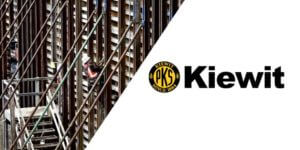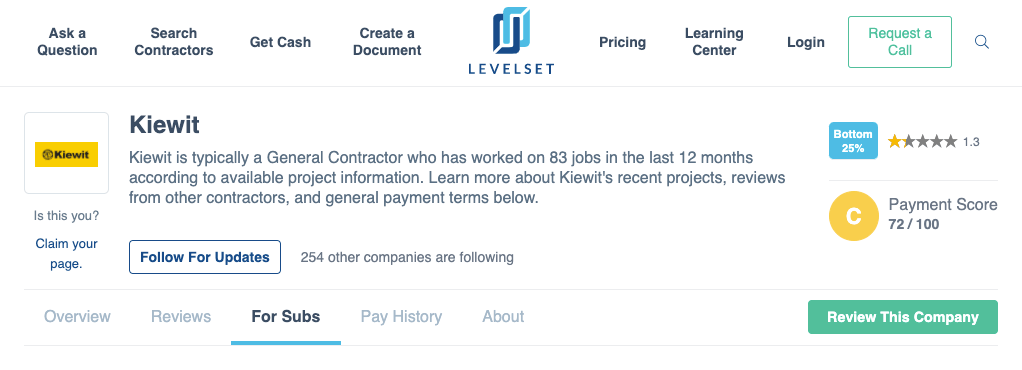
This subcontractors’ guide to Kiewit Corporation can help you learn more about them before signing a contract and starting a project. Whether you’ve worked with one of the nation’s top general contractors in the past or this is your first time, it’s always a good idea to do your research before you sign that subcontract.
Working on large projects looks great on your company’s portfolio and oftentimes signifies a great financial opportunity. This guide to Kiewit introduces you to their company, payment history, procurement practices, and payment practices, so you can get the most out of your project with Kiewit.
You can also find three tips that help you get paid on time with any general contractor and on construction projects of all sizes.
About Kiewit Corporation
Website: https://kiewit.com/
Kiewit Construction was founded in 1884 by brothers Peter and Andrew Kiewit in Omaha, Nebraska. Humble beginnings aside, Kiewit was tempered by hard times in American history, introducing them to the industry as a versatile and forward-looking company.
Throughout the Great Depression, Kiewit restructured and pivoted towards highway and heavy construction to brave the storm. After that, Kiewit contributed more than $500M worth of work to the U.S. military during WWII.
During the Cold War, Kiewit helped strengthen U.S. defenses, as well as played a key role in transporting materials and workers for a top-secret base in Thule, Greenland. Kiewit was also instrumental in U.S. infrastructure expansion, having constructed more lane-miles of interstate highway than any other contractor.
Since then, Kiewit has grown to become one of the largest general construction companies in the nation and the world. Kiewit boasted annual revenue of over $9B in 2018, and they currently sit at #5 on the ENR 2020 Top 400 Contractors list.
Kiewit has offices across the United States, as well as major operations in five Canadian provinces and one office in Mexico City.
Kiewit does business in seven main categories:
- Building
- Industrial
- Mining
- Oil, gas, and mineral
- Power
- Transportation
- Water/wastewater
A few of their representative projects include:
- The Fort Wainwright Barracks
- The Climax Mine 2010 Restart Project
- The San Miguel Lignite Mine
- The Tioga Gas Plant
- Rutherford Creek Power Project
- The I-225 Light Rail Line
- Yucca Mountain
Before Working With Kiewit
Large general contractors prequalify the subcontractors they work with to make sure they can do the work and comply with company policy. Subcontractors should also always prequalify their GCs.
Prequalifying a general contractor before you work with them helps you determine whether or not a project is worth taking on. Does the GC have the resources to manage a project of this type, collect payment from the owner, and distribute the funds accordingly?
You can prequalify any general contractor, including Kiewit, using the following five steps:
- Examine their payment history
- Look into their credit history
- Learn from subcontractors who have worked with the GC
- Get a feel for their payment process
- Find a sample subcontract and review the terms
The more you know about a new general contractor before you work with them, the better. Prequalification allows you to approach projects with added confidence because you have an idea for how the GC will handle it, how they interact with subcontractors, and when and how you’ll get paid.
Review Kiewit’s Payment Profile
You can begin prequalifying Kiewit on their Payment Profile. There, you can find subcontractor reviews for Kiewit, get subcontractor resources for working with Kiewit, see recent payment problems, and more.

Kiewit has a payment score of 72 out of 100, earning them a “C” grade. Levelset calculates payment scores by comparing a GC’s recent payment trends with tens of thousands of other companies across the country. The score is laid out on a scale of 0 to 100 and assigned an A through F rating. Kiewit’s letter rating is C.
Kiewit currently has two reviews, giving them a two-star rating out of five. The only feedback on their payment profile leaves two stars, stating:
“We had to send our invoices to them multiple times. The staff handling our documents changed and they did not seem to know how to distribute the documents out throughout their own departments for approval. The experience could have been better. We have future work with them and are hoping it goes more smoothly.”
Recent Payment Disputes
Kiewit only has one recent mechanics lien filing on record. It was filed on January 30, 2020, in Franklin, TN, for the amount of $65.4K.
There are also eight reported instances of slow payment since February of 2020. The reports come from projects located in Louisiana, Texas, and Tennessee.
There are many factors at play in the construction industry, and it’s important to remember that not all instances of slow payment and payment disputes are caused by the general contractor.
How to Get Prequalified to Work With Kiewit
The first step you need to take if to work on a Kiewit project is to go through their prequalification process. You can begin by going to their procurement page.
There, you’ll find an introduction to GEP SMART, the portal that Kiewit uses to store subcontractor and supplier contact information, review purchase requests, and create purchase orders. It’s also where you’ll fill out a form to get prequalified to work with the GC.
You’ll also find links to the PDF guide for the GEP SMART system in English, Spanish, and French.
Here’s a rundown of the information you’ll need to provide in order to register:
- General contact information for your company
- Contact information for your company representative
- Your DUNS number
- Your Tax ID
- Your VAT registration number
- Banking info
- Payment terms
Apart from procurement purposes, Kiewit uses GEP SMART to process invoices, communicate with subs and suppliers, and handle RFQs and RFPs as well.
You can begin the registration process on GEP SMART here.
Kiewit’s Payment Process
Now that we’ve taken a look at subcontractor and supplier prequalification with Kiewit, it’s time to get an idea for Kiewit’s payment process.
Subcontractors and suppliers working with Kiewit use GEP SMART to submit invoices, pay apps, and check on their payment status. Most of your communications and information requests will take place through GEP SMART as well.
This section is broken up into three parts:
- Before work begins
- Applying for a first payment
- Progress payments
- Final payments
Before work begins
After you’re prequalified and win the bid, there are a few things you need to provide before you can step foot on the jobsite. For a large general contractor like Kiewit, this usually involves:
- A copy of the subcontract
- Your insurance information
- Your W9
- Any required bonding information
All the information you need to provide will be requested by Kiewit through GEP SMART.
How to apply for first payment
When the time comes to apply for first payment, you’ll most likely be using the AIA billing forms. These include the G702 pay app and the G703 continuation sheet.
While you’re at it, make sure you review the A201 General Conditions – this agreement between Kiewit and the property owner has flow-down provisions that affect your payment rights.
It’s important that you fill out these forms as completely and accurately as possible because mistakes on your forms could lead to payment hiccups and delays. If this is your first time dealing with the G702 and G703 billing forms, take some time to look them over to make sure you understand what information you need to provide.
After you fill the forms out, you’ll submit them on GEP SMART. Additionally, the project administrator will reach out to you with any other documents or information you need to submit.
How to apply for progress payments
Progress payments are beneficial for both subcontractors and general contractors. They help keep the cash flowing on the project and they give general contractors a better picture of where their subcontractors are at over the course of the project.
If you want to apply for progress payments while you’re working with Kiewit, you will need to provide a pay application and a statement of values.
In some cases, you may need to agree to a lien waiver. No matter what the terms of the lien waiver are, make sure you read through the form carefully as lien waivers can void your lien rights should you go unpaid on the project.
How to apply for final payments
As the end of the project approaches, it’s time to think about the final payment. Applying for final payment on any construction project is different from applying for first payment and progress payments. That’s because you need to follow Kiewit’s closeout process.
To apply for final payment on a Kiewit project, you’ll most likely need to supply a detailed pay application, written consent from the surety (if applicable), and complete any closeout documents requested by Kiewit.
Again, you may be presented with a lien waiver in exchange for a promise of payment. Make sure you understand what you’re agreeing to before you sign anything.
3 Tips for Getting Paid With Kiewit Corporation
Regardless of who you’re working with, it’s important to set yourself up to get paid no matter what happens on a construction project. That’s because payment disputes stem from any number of issues that can occur on any project, large or small, public or private.
The three steps below are just a few best practices that can save you a lot of time, money, and hassle on a project that doesn’t go to plan.
1. Keep track of your deadlines.
Keeping track of the deadlines to submit pay apps, send construction notices, and file a mechanics lien or bond claim keeps you organized and poised to collect your payment in a timely fashion. Missing any one of these deadlines could limit your recovery options should there arise a non-payment issue.

Protect & speed up every payment
Learn how Levelset can help you easily manage your lien rights on every project to ensure your payments are always protected.
2. Always send a preliminary notice.
Sending preliminary notices on every project is one of the best ways to maximize your chances of getting paid on time. That’s because subcontractors who file preliminary notices often get pushed to the front of the payment line. Additionally, sending a notice is a prerequisite to filing a mechanics lien in most states, and failure to do so could void your lien rights.
3. Maintain your lien rights.
If you go unpaid on a construction project, filing a mechanics lien is one of the most effective ways to recover the money owed to you. Mechanics liens attach directly to the property, making it almost impossible to sell until you get paid. This interrupts progress on the project, and sometimes simply sending a notice of intent to lien is enough to motivate the parties up the chain to make a payment.
